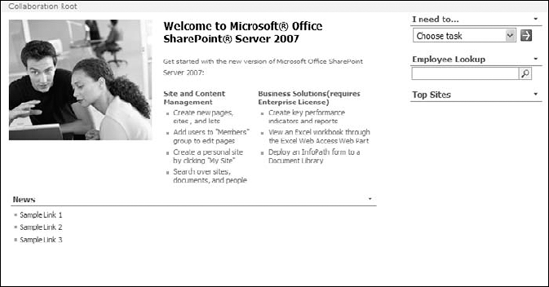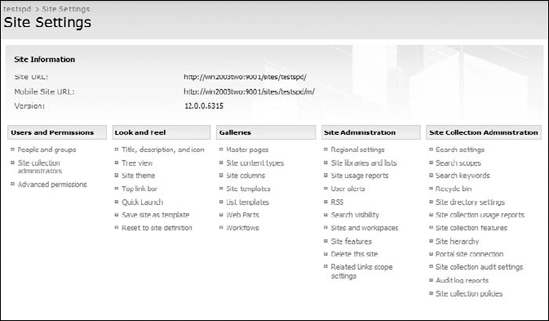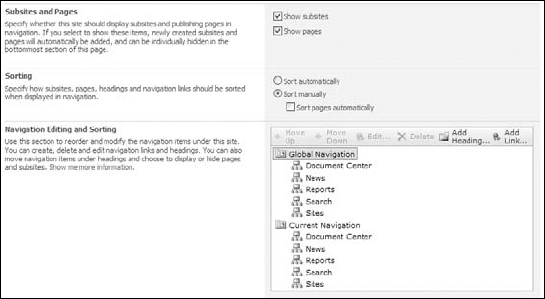 Understanding SharePoint Navigation Elements
by Vikram Kartik
Microsoft® Office SharePoint® Designer 2007 Bible
Understanding SharePoint Navigation Elements
by Vikram Kartik
Microsoft® Office SharePoint® Designer 2007 Bible
- Copyright
- About the Author
- Dedication
- Credits
- Acknowledgments
- Introduction
- Understanding the Technologies
- Developing Web Page Components
- Implementing Components and Controls
- Designing Web Sites
- Driving with Data
- Developing Workflows
- Managing and Publishing Web Sites
- Index
14.2. Understanding SharePoint Navigation Elements
SharePoint out of the box offers a number of controls that facilitate navigation across the Web site. Features such as Quick Launch bars, global navigation menus and tab controls, breadcrumb Web parts, etc., provide Web site designers with a number of ways to allow users to access content located across a Web site. The home page of a SharePoint Web site, as shown in Figure 14.4, has navigation controls and Web parts scattered all over the default Web page.
The Quick Launch bar is on the left pane, the site breadcrumb control is just above the content area, and the top navigation bar is just under the title of the Web page. Later in this chapter, I discuss how you can use these controls to your advantage while designing Web pages for SharePoint sites. Right now, though, I discuss the SharePoint interface for managing the navigation settings.
Figure 14.4. A SharePoint Web site using the Collaboration site template (available with MOSS)

14.2.1. Working with the Quick Launch bar
Whenever you create a new list, document library, or other forms of containers in SharePoint Designer, you have the option to add it to the Quick Launch bar. This bar is situated by default in many site templates on the left pane of the Web pages. Later in this section, the Quick Launch bar is implemented by using a set of controls (namely <asp:SiteMapDataSource> and <SharePoint:AspMenu>), which are at your disposal in SharePoint Designer to use on other Web pages or SharePoint Web part pages.
On WSS v3 sites, the Quick Launch bar and the Top Link bar can be edited in SharePoint Designer in a manner similar to the non-SharePoint navigation structure by using the Navigation pane. If you open a WSS v3 site and switch to the Navigation pane, the Quick Launch bar and the Top Link bar are shown there as the custom link bars. You can use the navigation pane to add new pages to the Quick Launch bars. Also, the WSS v3 site settings provide you with the Quick Launch bar and Top Link bar links under the Look and Feel section, as shown in Figure 14.5. Here, you can add or remove links from these bars.
To add new links to the Quick Launch bar, follow these steps:
Click the Quick Launch link in the Look and Feel section of the Site Settings page in the WSS v3 site.
Click New Link, type the URL and description of the new link, and then specify the heading created in step 2.
NOTE
The Quick Launch bar and Top Link bar links aren't available in Site Settings for Office SharePoint Server 2007 templates, such as Collaboration and Publishing.
Figure 14.5. The Look and Feel section in the WSS v3 site by using the Team Site template

14.2.2. Exploring SharePoint site navigation settings
For Office SharePoint Server 2007-specific templates, such as Collaboration and Publishing, the SharePoint navigation settings are editable to a certain extent by using the SharePoint user interface accessible to users with appropriate permissions under Site Actions ![]() Site Settings
Site Settings ![]() Modify Navigation. As shown in Figure 14.6, the Site Navigation Settings page allows you to specify whether to include subsites and pages in the site navigation and provides an interface to add new headings and links to the site navigation.
Modify Navigation. As shown in Figure 14.6, the Site Navigation Settings page allows you to specify whether to include subsites and pages in the site navigation and provides an interface to add new headings and links to the site navigation.
Figure 14.6. The Site Navigation Settings page on a site based on the Collaboration template

The settings that you make for this Web page apply to the tabbed top navigation menu that shows on the SharePoint Web pages just below the title of the Web site.
-
No Comment